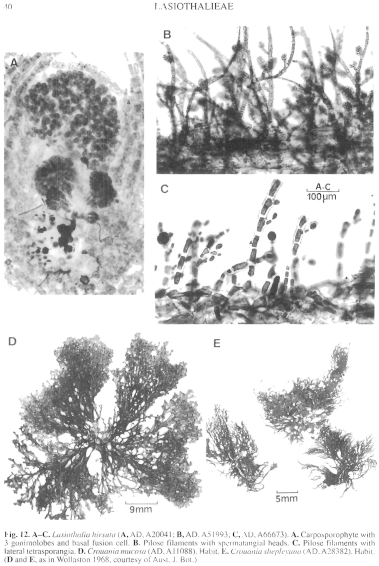|
|
|
|
|
|||||||||||
|
Electronic Flora of South Australia Species Fact Sheet
Phylum Rhodophyta – Order Ceramiales – Family Ceramiaceae – Tribe Crouanieae
Thallus (Figs 12D, 13F) medium to dark red-brown, fading to grey-red, 2–9 cm high, very mucoid, much branched irregularly with lax, often slightly curved branches of varying length, branches terete or slightly annular, usually basally constricted, smooth surfaced, tapering slightly from 1–1.5 mm in diameter in mid thallus to 400–600 µm just below apices. Holdfast discoid, 2–8 mm across with several axes; epilithic or occasionally epiphytic. Structure. Apices 10–20 cells long before initiation of whorl-branchlets, cells near apices (20–) 25–30 µm in diameter and L/D 0.7–1.2, increasing to 200–300 µm in diameter and L/D 1.2–2 in lower axes, with only slight cortication by rhizoids from the basal cells of whorl-branchlets; apices of axes often replaced and overtopped by apices from below; lateral branches arising from axial cells or the basal cell of whorl-branchlets. Whorl-branchlets 3 (Fig. 13L) per axial cell, 300–500 µm long, formed in spiral sequence, with 5–8 orders of (tri-) or quadrichotomies, with basal cells 20–30 µm in diameter and L/D 1.5–2, tapering to ovoid terminal cells 5–8 µm in diameter and L/D 1–1.5, often bearing a hair; terminal cells forming a continuous surface layer. Cells uninucleate; rhodoplasts discoid to elongate.
Reproduction: Gametophytes dioecious. Procarps (Fig. 13G) borne in succession near the apices of young lateral branches, replacing whorl-branchlets, with the supporting cell bearing a 4-celled carpogonial branch. Post-fertilization a connecting cell is cut off the carpogonium to connect with the auxiliary cell, which enlarges to form a foot cell and upper gonimolobe (Fig. 13I) and later other lateral gonimoblobes 200–500 µm across of ovoid carposporangia 15–40 µm in diameter. The carposporophytes occur in swollen branch ends (Fig. 13H), surrounded by whorl-branchlets. Spermatangia (Fig. 13J) are borne terminally on outer cells of whorl-branchlets, elongate and dumb-bell shaped, 2–3 µm in diameter.
Tetrasporangia (Fig. 13K, L) occur on the basal cells of whorl-branchlets, sessile, subspherical, 50–80 µm in diameter, tetrahedrally divided.
Type from Robe, S. Aust., lower eulittoral (Womersley, 30.viii.1949); holotype and isotypes in AD, A11088 – "Marine Algae of southern Australia" No. 95.
Selected specimens: Elliston, S. Aust., reef surface (Womersley, 14.i.1951; AD, A14953). Pearson Is, S. Aust., upper sublittoral (Specht, 17.ii.1960; AD, A24508). Cape Carnot, S. Aust., low eulittoral pools (Womersley, 8.i.1951; AD, A13696). Vivonne Bay, Kangaroo I., S. Aust., upper sublittoral on jetty (Kraft & Min Thein, 30.xi.1971; AD, A41424). Pennington Bay, Kangaroo I., S. Aust., reef surface (Womersley, 23.viii.1950; AD, A13393) and on Caulerpa brownii (Kraft 4914, 16.i.1974; MELU). Cape Buffon, S. Aust., low eulittoral (Womersley, 27.ix.1992; AD, A62774 - "Marine Algae of southern Australia" No. 95a). Port Phillip, Vic. (Wilson, LD, as C. australis). Rocky Cape, NW Tas., lower eulittoral pools (Womersley, 17.x.1982; AD, A55607). Low Head, Tas. (Perrin, 8.vii.1951; AD, A49638).
Distribution: Elliston, S. Aust., to Port Phillip, Vic., and N Tasmania.
Taxonomic notes: C. mucosa is a distinctive species, being highly mucilaginous and occurring mainly in shallow water on wave-swept rock platforms.
References:
WOLLASTON, E.M. (1968).Morphology and taxonomy of southern Australian genera of Crouanieae Schmitz (Ceramiaceae, Rhodophyta). Aust. J. Bot. 16, 217–417.
The Marine Benthic Flora of Southern Australia Part IIIC complete list of references.
Publication:
Womersley, H.B.S. (24 December, 1998)
The Marine Benthic Flora of Southern Australia
Rhodophyta. Part IIIC. Ceramiales – Ceramiaceae, Dasyaceae
©State Herbarium of South Australia, Government of South Australia
Illustrations in Womersley Part IIIA, 1998: FIGS 12D, 13 F–L.

Figure 12 enlarge
Fig. 12. A–C. Lasiothalia hirsuta (A, AD, A20041; B, AD, A51993; C, AD, A66673). A. Carposporophyte with 3 gonimolobes and basal fusion cell. B. Pilose filaments with spermatangial heads. C. Pilose filaments with lateral tetrasporangia. D. Crouania mucosa (AD, A 11088). Habit. E. Crouania shepleyana (AD, A28382). Habit. (D and E, as in Wollaston 1968, courtesy of Aust. J. Bot.)

Figure 13 enlarge
Fig. 13. A–E. Lasiothalia hirsuta (AD, uncertain). A. Axial cells, with opposite whorl-branchlets bearing ascending and descending cortical rhizoids with outward, curved, pilose filaments. B. Indefinite pilose filaments bearing young carpogonial branches. C. Carpogonial branches near the apex of a pilose filament. D. A carposporophyte with 4-5 lobes of carposporangia. E. Pilose filaments with spermatangial heads. F–L. Crouania mucosa (AD, Al 1088). F. Thallus with new axial branches arising below older apices. G. Carpogonial branch (with spermatium on trichogyne) and supporting cell on an axial cell. H. Female thallus with clavate branch apices bearing carposporophytes. I. Carposporophyte with mature and young gonimolobes arising from central cell. J. Whorl-branchlet bearing spermatangia. K. Thallus with tetrasporangia. L. Cross section of branch with tetrasporangia. (All as in Wollaston 1990, courtesy of Bot. Mar. and 1968, courtesy of Aust. J. Bot.)

|
Email Contact: State Herbarium of South Australia |

|